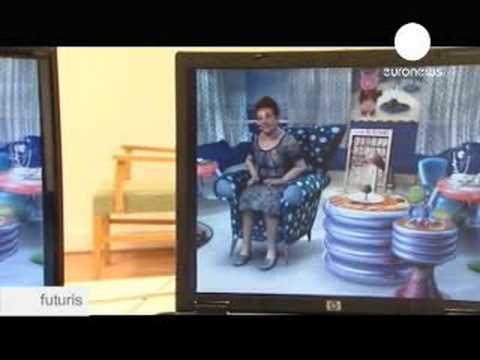Thomas Brune, Streaming Interfaces Project Leader, Thomson R&D: ”What we have here is the Viper film stream camera – so that is the first generation of digital film cameras, before that it was all celluloid-based, now it’s digital, and we developed a [memory] storage for that also, so it’s completely independent of power currents”.
Cheaper, simplier and more reliable equipment for the European film industry-that’s the goal of IP-RACINE an international research project. Scientific and industrial organisations from eight European countries are working toward a European digital cinema “from scene to screen.”
Benoit Michel, IP-RACINE project spokesman: ”Studios from Hollywood imposed their own view, and then Europe found that it was really worth to have some kind of addition to that standart that answers our European concerns for multicultural, multilingual cinema”.
Digital cameras, formally scorned by filmakers because of their inferior quality. are becoming more and more advanced.
At the same time the electronic componants are becoming cheaper, making professional editing equipment affordable even for small studio’s.
Thomas Brune: “People can use off-the-shelf 10-Gigabit ethernet switches from the network market for that”.
Digital production makes it easier for the filmmakers to create complex video and sound effects essential in today’s cinema.
Philippe Bekaert, Professor of Hasselt University, EDM Project Manager: ”One distinctive feature of using many cameras is that they give you information about three-dimensional structure. Having that information available, we we’re able to create time-slicing effects in a much more economic, much more easy way”.
The positioning of the camera’s and the props in the studio can be calculated using specially developed algorithms. Computors then use the data to create a realistic virtual 3D space, giving total creative freedom to filmakers.
Steroscopic cinema is one of the most commercially attractive applications of digital methods. The technology has been greatly improved in recent years. Using special glasses, viewers can now experiance realistic 3D shows without side effects such as headaches or motion sickness.
Benoit Michel: ”All the big cinema studios at Hollywood are certain that 3D is the thing that will bring audiences back to cinema and keep them interested for at least next 10 years. The big animation studios like Disney have announced that they will be producing only the 3D cartoons to distribute both in regular cinemas and 3D-equipped ones starting from this year .”
What about home viewing…3D cinema uses special “silver screens” which are too expensive for home use. But as a 3DTV project coordinator explains, steroscopic TV is just around the corner.
Steroscopic displays use the same principles as stereo cinema, showing slightly different images to the left and right eye. Stereo TV sets are due in the shops in a year or so, they don’t require special glasses-but they have other limitations.
Levent Onural, 3DTV project coordinator: ”It will pretty much look like a regular TV, when you’re not using it – but when it’s turned on you’ll see the images flowing into the room or going back from the TV. However, to see the proper 3D effect you have very little freedom: you can’t move too close or too far away”.
As impressive as stereo might be it’s still far from real 3D. Creating a moving holographic image- like the famous “ghost images” from SCI-FI movies is still impossible, but work is ongoing to make that possible. Potential uses range from medical imaging and museum exhibitions to telepresence and videogames.
Levent Onural: “My prediction is: within 8 to 10 years we will have lab prototypes of decent holographic TV. The TV set will be something like a coffee table, in the middle of the room, people will be watching it freely without any bad feeling like motion sickness or whatever. There will be a ghost-like image coming up from that coffee table. You can move around it freely, you can watch it from the backside or from the frontside if you wish. And that will be the TV of the future.”
At present, the digital revolution in the industry is making film roles obsolete. The movies can now be shipped to theatres on reusable hard drives. Each of the digital copies can have several sound tracks and subtitles in different languages, giving the cinema’s greater flexibility in targetting a multicultural audience.





